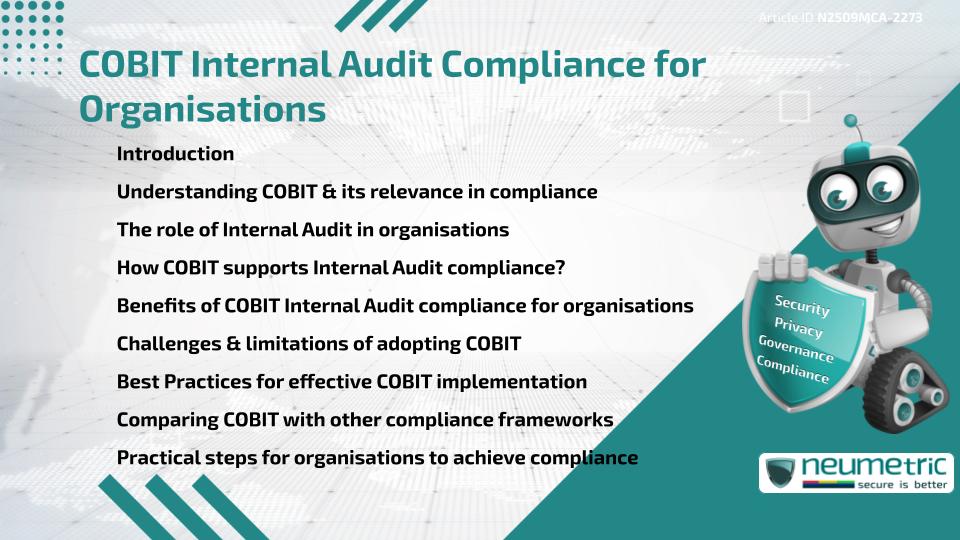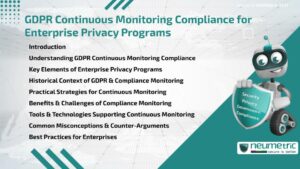Table of Contents
ToggleIntroduction
COBIT Internal Audit compliance ensures that organisations align Governance, Risk & control practices with recognised Global Standards. It provides a structured way to evaluate processes, improve transparency & strengthen accountability. With its emphasis on Governance, control objectives & performance management, COBIT bridges the gap between business goals & regulatory expectations. For organisations, it not only supports compliance audits but also helps streamline decision-making, reduce operational Risks & safeguard Stakeholder confidence.
Understanding COBIT & its relevance in compliance
Control Objectives for Information & Related Technologies [COBIT] is a globally recognised Framework developed by ISACA to guide information Governance & management. At its core, COBIT helps organisations implement structured controls & ensure that business processes align with strategic goals. Compliance in this context means meeting both internal Governance requirements & external regulatory obligations.
According to ISACA’s official guidance, COBIT integrates principles of Governance, assurance & Risk Management. This makes it particularly relevant for organisations that operate in regulated sectors such as Finance, Healthcare & Government.
The role of Internal Audit in organisations
Internal Audit functions act as the independent eyes & ears of management. They evaluate Risk exposure, compliance gaps & operational efficiency. In essence, Internal Audit is the mechanism that verifies whether an organisation is doing what it claims in terms of Policies, controls & reporting.
Without structured frameworks, audits may become inconsistent or overly subjective. This is where frameworks like COBIT provide valuable benchmarks for uniform evaluation.
How COBIT supports Internal Audit compliance?
COBIT Internal Audit compliance ensures that Audit activities are not isolated tasks but aligned with organisational Governance structures. The Framework maps Business Objectives to control objectives, making it easier for Auditors to test whether controls are in place & effective.
For example, COBIT includes domains such as “Evaluate, Direct & Monitor” and “Align, Plan & Organise”, which directly correspond to key areas of Audit Assessment. By following COBIT, auditors can structure their work around these domains & provide comprehensive assurance.
Benefits of COBIT Internal Audit compliance for organisations
Organisations adopting COBIT Internal Audit compliance often experience several benefits:
- Enhanced transparency in reporting & decision-making
- Stronger alignment between IT operations & business goals
- Reduced Risks of fraud, error & regulatory penalties
- Better communication between management, auditors & regulators
- Standardisation of control processes across departments
These benefits foster a culture of accountability & trust, both internally & externally.
Challenges & limitations of adopting COBIT
Despite its strengths, COBIT is not without challenges. Implementing it requires skilled professionals, organisational buy-in & ongoing training. Smaller organisations may find it resource-intensive. Additionally, COBIT does not provide highly detailed step-by-step controls; rather, it offers broad principles that must be customised.
As a result, organisations may face difficulties if they lack sufficient expertise or leadership support. Guidance on overcoming these challenges can be found in CISA Review’s insights on COBIT.
Best Practices for effective COBIT implementation
To make COBIT Internal Audit compliance effective, organisations can follow several Best Practices:
- Secure top-level leadership support to drive adoption
- Conduct a Readiness Assessment before implementation
- Train Internal Audit teams on COBIT principles & processes
- Integrate COBIT with existing compliance tools & methodologies
- Continuously monitor & update practices in line with regulatory changes
These practices ensure that COBIT becomes a living Framework rather than a one-time compliance effort.
Comparing COBIT with other compliance frameworks
COBIT is often compared with frameworks like COSO, ITIL & ISO 27001. While COSO focuses broadly on enterprise Risk Management & ITIL targets IT service management, COBIT strikes a balance between IT Governance & organisational compliance.
Unlike ISO 27001, which focuses on Information Security, COBIT encompasses a wider range of Governance & performance objectives. A comparative analysis is available from ERM Initiative’s Framework resources.
Practical steps for organisations to achieve compliance
For organisations aiming to achieve COBIT Internal Audit compliance, the following steps are practical starting points:
- Identify Business Objectives & map them to COBIT domains
- Define control activities aligned with Governance requirements
- Establish Audit criteria based on COBIT standards
- Conduct periodic self-assessments before external audits
- Use COBIT maturity models to track progress & improvements
These steps create a structured pathway from policy to practice, ensuring compliance is measurable & repeatable.
Conclusion
COBIT Internal Audit compliance provides organisations with a structured way to balance Governance, regulatory requirements & business performance. It enhances Audit quality, reduces Risks & supports decision-making at every level of the organisation.
Takeaways
- COBIT is a Governance & compliance Framework that supports effective auditing.
- Internal Audit teams benefit from structured benchmarks & objectives.
- Organisations can reduce Risks & improve transparency with proper COBIT adoption.
- Best Practices include leadership support, training & ongoing assessments.
FAQ
What is COBIT Internal Audit compliance?
It refers to the alignment of Internal Audit practices with COBIT’s Governance & control objectives to ensure effective compliance & oversight.
Why is COBIT important for compliance audits?
COBIT provides a structured Framework that links business goals with control activities, making audits more reliable & consistent.
How does COBIT differ from ISO 27001?
While ISO 27001 focuses on Information Security, COBIT covers a wider scope of Governance, performance & compliance across an organisation.
What challenges do organisations face with COBIT?
Challenges include resource intensity, the need for skilled professionals & the requirement to customise COBIT’s broad principles to fit specific needs.
Can small organisations use COBIT?
Yes, but they may need to adapt COBIT principles on a smaller scale to avoid excessive complexity.
Does COBIT replace Internal Audit procedures?
No, it complements Internal Audit by providing structured Governance objectives & benchmarks for assessments.
Where can organisations learn more about COBIT?
Resources are available from ISACA & other professional Governance sites that provide implementation guidance.
Need help for Security, Privacy, Governance & VAPT?
Neumetric provides organisations the necessary help to achieve their Cybersecurity, Compliance, Governance, Privacy, Certifications & Pentesting needs.
Organisations & Businesses, specifically those which provide SaaS & AI Solutions in the Fintech, BFSI & other regulated sectors, usually need a Cybersecurity Partner for meeting & maintaining the ongoing Security & Privacy needs & requirements of their Enterprise Clients & Privacy conscious Customers.
SOC 2, ISO 27001, ISO 42001, NIST, HIPAA, HECVAT, EU GDPR are some of the Frameworks that are served by Fusion – a SaaS, multimodular, multitenant, centralised, automated, Cybersecurity & Compliance Management system.
Neumetric also provides Expert Services for technical security which covers VAPT for Web Applications, APIs, iOS & Android Mobile Apps, Security Testing for AWS & other Cloud Environments & Cloud Infrastructure & other similar scopes.
Reach out to us by Email or filling out the Contact Form…





